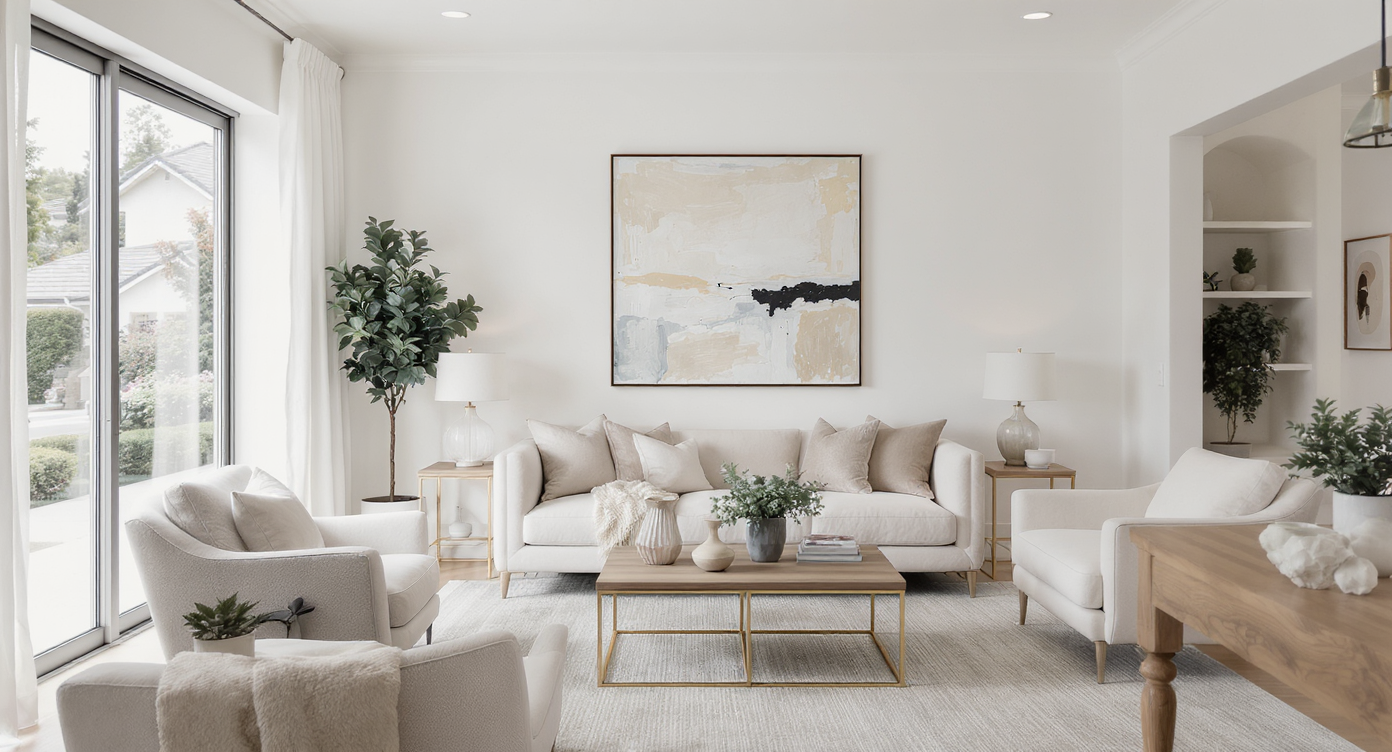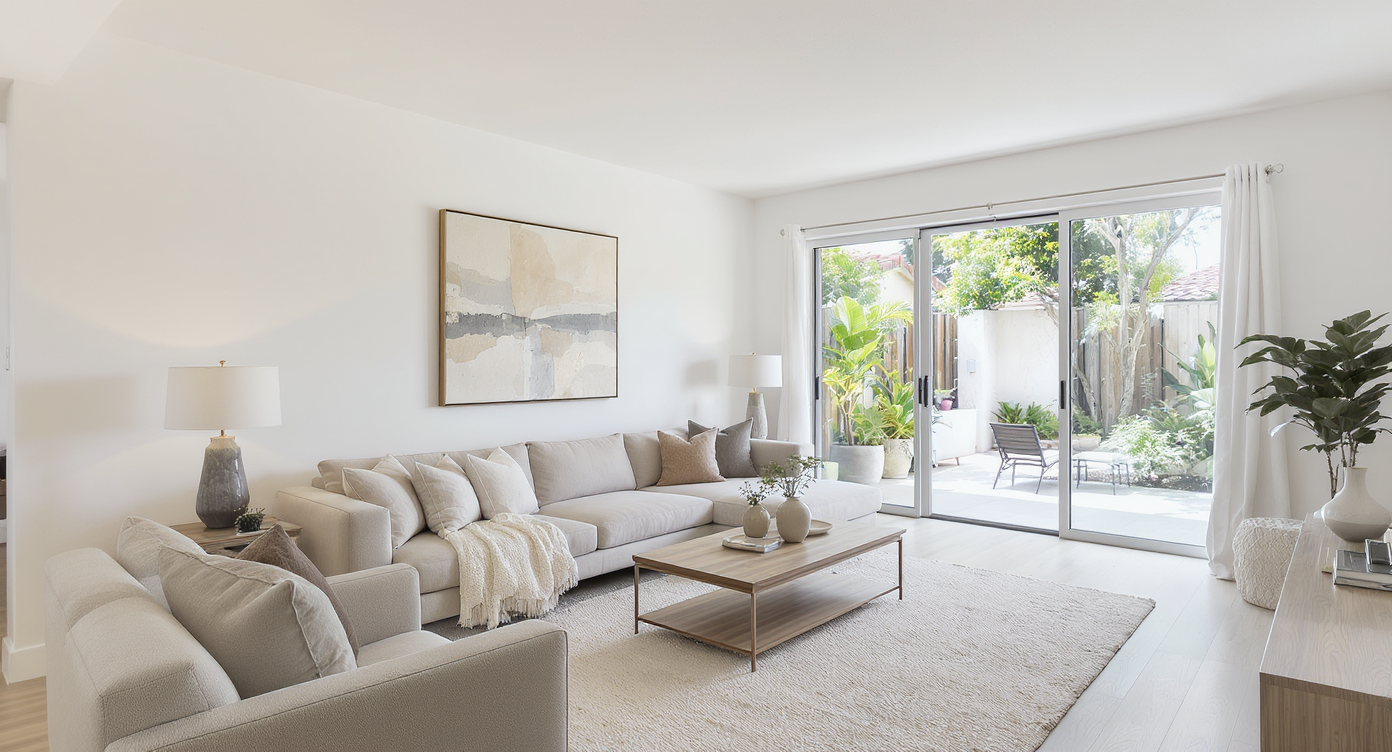TL;DR
South Bay homes look bland because the dominant 2025 real estate trend is neutral staging, not personal interior design. In high-cost California real estate, buyers are mostly paying for land and location, not finishes — a key reason expensive homes can look dated. Long-tail keyword: why expensive South Bay homes look dated.
The emotional whiplash of million-dollar beige

Typical South Bay listings feature neutral staging to appeal broadly, reflecting market-driven design choices.
Open any Silicon Valley listing and you’ll find the same thing: white walls, beige sofas, a giant abstract over the couch. It’s not a personality issue. It’s a market strategy. Here’s the thing: in the South Bay, “luxury price” rarely equals “luxury interior design.” Prices are driven by land, school districts, commute, microclimate, and views. Interiors lag because the sellers are often long-term owners with little incentive to renovate, and because agents default to neutral staging to court the widest group of buyers. Culturally, California favors casual, indoor-outdoor living over high-gloss polish. Pair that with tax rules that discourage major remodels, and you get homes that feel frozen in time — even at three, four, or five million dollars. The 2025 trend isn’t about flash. It’s about selling possibility.
The big picture behind bland
Across the South Bay, three themes unite what you see online: neutral home staging, land-first valuation, and pragmatic renovation timelines. Real estate agents stage to sell space, not taste, so neutral interiors and soft textures dominate the feed. Designers often note that buyers pay attention to floor plan, natural light, and neighborhood more than a trendy backsplash. In California real estate, market value is typically weighted toward location and lot size, which is why dated but well-sited homes compete closely with renovated ones. Add in long tenure and property tax incentives to avoid major improvements, and it’s easy to see why listings skew beige. Search terms you’ll encounter: home staging, neutral interiors, California real estate, Silicon Valley homes, and land value vs house value. Alt text suggestion: neutral staged living room with large windows in Los Gatos.
Anecdote
A South Bay seller repainted her richly colored dining room to soft white on her agent’s advice. Showings doubled and she netted multiple offers the first weekend.
5 South Bay design trends shaping how luxury listings look in 2025
Neutral Staging, Not Personal Interior Design - Home Staging
Agents estimate that staging budgets commonly run 0.3-0.5 percent of list price, so the furniture you see is curated to offend no one and sell fast. In 2025, South Bay listings lean on neutral interiors because that palette photographs cleanly, reads larger, and lets buyers imagine their own style. What looks like “boring” is usually rental furniture chosen by a staging coordinator, not the owner’s decor. Expect off-white walls, pale sofas, a pop of moss or navy, and oversized art. Some listings use virtual staging or scaled-down beds to make rooms feel bigger, so rely on floor plans and measurements. Experts recommend focusing on window placement, ceiling height, and circulation, because those fundamentals drive daily comfort and resale more than a rug ever will. Alt text suggestion: staged neutral living room with abstract art and light oak floors.How to Bring It Home
- When touring, ignore accessories and check sightlines, outlet placement, and daylight at 9 am vs 4 pm.
- If you love neutrals, add depth with linen, wool, unlacquered brass, and limewash rather than more gray.
- Ask whether photos are virtually staged and confirm real furniture sizes on site.
Land Over Lux - California Real Estate
In prime Silicon Valley, a large share of price can sit in the dirt itself, with many assessments allocating the majority of value to the lot rather than the structure. That’s why two homes on the same block can sell within a narrow range even if one has a new kitchen and the other is unapologetically 2003. Buyers pay for location, schools, and microclimate first; finishes become a bonus. Designers often advise scoring a home on three axes before you fall for a backsplash: light, layout, and lot. If those rank high, planned updates will sing. As a rule of thumb, expect the difference between a tastefully updated home and a dated but sound one to be far smaller than the cost to rebuild on the same parcel.How to Bring It Home
- Prioritize south and east light, ceiling heights of 9 feet or more, and logical kitchen-work triangle spacing of 4-9 feet between zones.
- Compare survey lines, setbacks, and mature tree canopy alongside comps.
- Budget improvements in phases to protect cash flow.
Tax-Locked Interiors - Prop 13 and Renovation Freeze
California’s 2 percent property tax cap can discourage major remodels because significant improvements may add to the assessed value and raise annual taxes. Translation: many long-time owners keep perfectly functional interiors for decades, then list with fresh paint and staging instead of tearing out cabinets. A simple example illustrates the behavior: if an owner with a low assessed value adds hundreds of thousands in improvements, their annual tax bill can jump by thousands. Experts recommend that buyers plan their own updates post-close rather than expecting sellers to do costly remodels before listing in the South Bay.How to Bring It Home
- Talk to a local agent and tax pro about what kinds of improvements may trigger reassessment.
- Prioritize energy upgrades, lighting, and storage that improve daily life without overcapitalizing.
- Phase big projects across 12-24 months to align with permits and cash.
Tear-Downs and Fast Flips - Remodeling Reality
In hot pockets, buyers often plan to gut or rebuild, while flippers default to quick, durable finishes that can look same-same from listing to listing. Expect resilient floors, shaker cabinets, and black hardware because they are fast to install and broadly appealing. Permit timelines of several months are common, and a quality Bay Area kitchen remodel can range roughly from the high five figures into the low six figures depending on scope. Designers often advise budgeting 5-10 percent of the purchase price for phased upgrades over the first three years for a house you plan to keep.How to Bring It Home
- Spend first on layout corrections, lighting layers, and acoustics before decorative swaps.
- Ask for permit history and contractor warranties to separate cosmetic refreshes from real improvements.
- Use moodboards to avoid defaulting to gray LVP and trend-chasing tile.
California Casual Over City Gloss - Interior Design
South Bay homes favor indoor-outdoor flow, easy-care materials, and grounded color over high-contrast, high-shine finishes. Think plastery taupes, warm oak, tumbled stone, and textiles that can survive kids, pets, and trail dust. Many homeowners fear “tacky” more than “boring,” so they choose white and gray by default. Experts recommend warming the palette with ochre, clay, and green, and using curves, fluted details, and mixed metals to add character without fighting the landscape. If you’re coming from NYC polish, remember: this region equates luxury with light, calm, and nature, not just statement marble.Where trends overlap — and where buyers slip up
Though each trend feels distinct, they all circle the same truth: buyers are purchasing potential, not perfection. Land-first valuation, neutral staging, and tax-influenced renovation cycles create a consistent look online - calm, clean, and slightly anonymous. Shared materials and colors lean warm-neutral: oak, limewash, textural rugs, unlacquered brass. The mindset shift is pragmatic: invest in bones, fix the lighting, let the rest evolve. Designers often advise that a great floor plan saves more money than any single finish because it reduces future rework and boosts daily joy.
What People Often Get Wrong About 2025 Design Trends
- Thinking staging equals how people live - it’s merchandising. Ask for pre-stage photos and floor plans.
- Assuming a $3M price guarantees turnkey interiors - in the South Bay you’re often paying for the lot.
- Over-remodeling immediately - phase updates to learn how the home behaves through a full season.
- Chasing trends over comfort - every soft neutral needs contrast, texture, and light to feel intentional.
- Ignoring permits and timelines - even “simple” projects can take months, so plan occupancy accordingly.
Real-world wisdom, tools, and next steps
Expert Insights & Mini-Anecdotes
“Sell the space, not your stuff,” one South Bay agent likes to say, explaining why staging strips homes down to beige basics. A moving crew lead told me most clients request white and gray because they’re more afraid of looking tacky than looking boring - a quiet reason so many listings blend together. A seller in Willow Glen begrudgingly painted her cinnamon-red dining room soft white on her agent’s advice, then watched buyers linger longer and offers rise. And yes, a 1980s oak-and-beige home in a prime enclave recently attracted a cash buyer who planned to gut it - the land and light were the real luxuries. Designers often advise: correct layout and lighting first, then layer materials that feel good in the hand - linen, wool, limewash, soapstone. Another rule: pick one hero per room, whether it’s a sculptural sofa or a moss-green rug, and let everything else support it.Tools, Resources & Visualization
Use ReimagineHome to test warm neutrals, swap in a sculptural sofa, or visualize a fluted island in your South Bay kitchen. You can even compare virtual staging to your real furniture footprint before you buy. Picture a living room with taupe limewash, oak beams, linen drapery, and a single brass sconce catching late-afternoon light - quiet luxury without pretense. Alt text suggestion: warm neutral living room with oak beams, limewashed walls, and brass accents.Visualization Scenario
Use ReimagineHome to preview taupe limewash against your actual windows, swap your sofa for a sculptural curved option, and test a moss-green rug before you click buy.
FAQ
- Why do expensive South Bay homes look dated? In Silicon Valley, buyers pay mostly for land and location, so sellers lean on neutral staging and avoid costly remodels. The result is clean but impersonal interiors that photograph well.
- Am I paying for the land or the house in the Bay Area? In many South Bay neighborhoods, most of the value sits in the lot, schools, and microclimate. Experts advise prioritizing light, layout, and site over finishes when comparing listings.
- How does Prop 13 affect home renovations? California’s tax cap limits annual increases, but significant improvements can add to the assessed value and raise taxes. Many owners delay big remodels and list with fresh paint and staging instead.
- Should I renovate before selling a South Bay home? Agents often recommend paint, repairs, and staging over full remodels because buyers prefer to customize. Quick updates yield better ROI and faster sales than heavy construction before listing.
- How do I look past staging when buying? Bring a tape measure, study floor plans, and tour at different times of day to judge light. Evaluate outlets, storage, and circulation, not the throw pillows.
The real luxury hiding behind beige
If the listings look sleepy, it’s because the South Bay sells promise more than polish. The market rewards neutral staging, solid bones, and locations that make daily life easier. For buyers, the win is philosophical: invest in light, layout, and landscape, then layer in soul at your own pace. In 2025, design here isn’t about maximal reveals on day one. It’s about patient improvement, tactile materials, and spaces that breathe. Once you see past the beige, you’ll spot what truly matters - the canvas is calm so your life can provide the color.
.svg)

.svg)









.png)